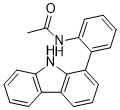GeA-69 (GeA69) is a novel, potent and selective allosteric inhibitor of poly-adenosine-diphosphate-ribose polymerase 14 (PARP14) targeting macrodomain 2, with a Kd of 2.1 µM.
Physicochemical Properties
| Molecular Formula | C20H16N2O |
| Molecular Weight | 300.353844642639 |
| Exact Mass | 300.13 |
| Elemental Analysis | C, 79.98; H, 5.37; N, 9.33; O, 5.33 |
| CAS # | 2143475-98-1 |
| Related CAS # | 2143475-98-1 |
| PubChem CID | 135397654 |
| Appearance | White to off-white solid powder |
| LogP | 4.2 |
| Hydrogen Bond Donor Count | 2 |
| Hydrogen Bond Acceptor Count | 1 |
| Rotatable Bond Count | 2 |
| Heavy Atom Count | 23 |
| Complexity | 437 |
| Defined Atom Stereocenter Count | 0 |
| InChi Key | LDPDVNYCIOHPGF-UHFFFAOYSA-N |
| InChi Code | InChI=1S/C20H16N2O/c1-13(23)21-18-11-4-2-7-14(18)16-9-6-10-17-15-8-3-5-12-19(15)22-20(16)17/h2-12,22H,1H3,(H,21,23) |
| Chemical Name | N-[2-(9H-carbazol-1-yl)phenyl]acetamide |
| Synonyms | GeA69; GeA-69; GeA 69 |
| HS Tariff Code | 2934.99.9001 |
| Storage |
Powder-20°C 3 years 4°C 2 years In solvent -80°C 6 months -20°C 1 month Note: Please store this product in a sealed and protected environment, avoid exposure to moisture. |
| Shipping Condition | Room temperature (This product is stable at ambient temperature for a few days during ordinary shipping and time spent in Customs) |
Biological Activity
| Targets | PARP14 ( Kd = 2.1 μM ) |
| ln Vitro | GeA-69 (compound 1) at 50 μM and 250 μM, with pre-damage for 1 hour or 0.5, 1, 2.5 min, engages PARP14 MD2 in intact cells and stops it from localizing to DNA damage sites in U-2 OS cells[2]. In HeLa, U-2 OS, and HEK293 cells, GeA-69 (25 nM-250 μM; 72 h) demonstrates moderate cytotoxicity and high cell permeability, with 2% passing paracellularly and 98% transcellularly across the membrane[2]. |
| Cell Assay |
Cell Line: HeLa, U-2 OS and HEK293 cells Concentration: 25 nM-250 μM Incubation Time: 72 hours Result: Resulted moderate cytotoxicity against normal cells with EC50_HeLa=58 µM, EC50_U-2 OS=52 µM, EC50_HEK293=54 µM. |
| References |
[1]. Discovery of a Selective Allosteric Inhibitor Targeting Macrodomain 2 of Polyadenosine-Diphosphate-Ribose Polymerase 14. ACS Chem Biol. 2017 Nov 17;12(11):2866-2874. [2]. Discovery of a novel allosteric inhibitor scaffold for polyadenosine-diphosphate-ribose polymerase 14 (PARP14) macrodomain 2. Bioorg Med Chem. 2018 Jul 15;26(11):2965-2972. |
Solubility Data
| Solubility (In Vitro) |
DMSO: ~60 mg/mL (~199.8 mM) Ethanol: ~10 mg/mL |
| Solubility (In Vivo) |
Solubility in Formulation 1: ≥ 2.08 mg/mL (6.93 mM) (saturation unknown) in 10% DMSO + 40% PEG300 + 5% Tween80 + 45% Saline (add these co-solvents sequentially from left to right, and one by one), clear solution. For example, if 1 mL of working solution is to be prepared, you can add 100 μL of 20.8 mg/mL clear DMSO stock solution to 400 μL PEG300 and mix evenly; then add 50 μL Tween-80 to the above solution and mix evenly; then add 450 μL normal saline to adjust the volume to 1 mL. Preparation of saline: Dissolve 0.9 g of sodium chloride in 100 mL ddH₂ O to obtain a clear solution. Solubility in Formulation 2: ≥ 2.08 mg/mL (6.93 mM) (saturation unknown) in 10% DMSO + 90% Corn Oil (add these co-solvents sequentially from left to right, and one by one), clear solution. For example, if 1 mL of working solution is to be prepared, you can add 100 μL of 20.8 mg/mL clear DMSO stock solution to 900 μL of corn oil and mix evenly. (Please use freshly prepared in vivo formulations for optimal results.) |
| Preparing Stock Solutions | 1 mg | 5 mg | 10 mg | |
| 1 mM | 3.3294 mL | 16.6472 mL | 33.2945 mL | |
| 5 mM | 0.6659 mL | 3.3294 mL | 6.6589 mL | |
| 10 mM | 0.3329 mL | 1.6647 mL | 3.3294 mL |
